Sub-Tropic Adventures, St. Helena, South AtlanticContents of this Issue: Sub-Tropic Adventures, St. Helena, South Atlantic Good News about Saving America’s Reefs Tough Times in the Dive Travel Industry Into the Planet — My Life as a Cave Diver Plenty of Tales of Woe Among Traveling Divers Airline Ticket Refunds; It’s the Law! Can You Trust Your Dive Guide? Jack Randall, the Original Fish ID Book Author, Passes Have You Ever Surfaced and Been Lost? Nature Takes Advantage of the Lockdown Undercurrent Readers’ Rescue Australian Wildlife from the Devastating Fires Is it Bad News for Divers Who Suffer COVID-19? Bigger Fish Suffer More from Climate Change Editorial Office: Ben Davison Publisher and Editor Undercurrent 3020 Bridgeway, Suite 102 Sausalito, CA 94965 Incredible diving in the middle of nowhere from the May, 2020 issue of Undercurrent
See some photos here: https://www.undercurrent.org/StHelena Dear Fellow Diver, When prompted by the dive operator, Anthony Thomas, I back-rolled off the crowded and well-worn 20-foot Rigid Inflatable Boat (RIB) and was instantly met by cold disappointment. After catching my breath from the punch of 75°F water rushing through my 2.5mm shorty, my first thought was that the visibility would be great if not for all the damn fish. "That must be what it's like inside a snow-globe," my wife/buddy later stated.
Our trek began at JFK on Thursday morning and ended Saturday afternoon, Leap Day 2020, at the nearly 3-yearold St. Helena airport. Fifteen hours to Johannesburg, an overnight, then a Saturday morning SAA AirLink flight to St. Helena; in October 2017, this once-a-week, same-day in-and-out flight replaced the five-day Royal Mail Ship journey from Capetown for travelers. Built on a cliff, the airport has been dubbed by the British press as both the most dangerous and most useless airport on the planet while costing 250 million British pounds with the hope of bringing tourism to this island with less than 5,000 souls. After a British Airways subsidiary airline discovered the shear winds and challenging landings, it decided against establishing a permanent route, so a South Africa Airlines subsidiary (AirLink) uses an Embraer 190 to make the weekly journey from JoBerg, with a necessary stop in Namibia for refueling. You see, as St. Helena is 1200 miles from the African Coast, the flight needs to have enough fuel to perform six loops over the airport for visibility issues or attempt up to three landings before aborting and heading for an overnight to Ascension Island, 700 miles to the northwest, then making another attempt the next day. Thankfully, neither our arriving nor departing flights had any problems. Our arrival flight had 47 passengers spread throughout the 99 seats; weight limits driven by the challenging airport winds preclude full flights. Most of the travelers were returning locals, known as "Saints", with some government workers mixed in. During my week, I counted 11 airarrival diving tourists, as well as some yachties passing through on their way sailing around the world. The island's coastline is mostly high cliffs interrupted by steep weathered valleys that wash into the sea. We were met at the airport by the personable Anthony M. Thomas, the owner of Sub- Tropic Adventures, and our English tour leader, Christopher Bartlett, and driven to Jamestown. Our hotel, the Mantis, is a smartly renovated hotel occupying former officers' quarters, behind St. James Church (1774), the oldest Anglican church in the Southern Hemisphere. Down an open stairway, my room was spacious, modern, and well-appointed, with a safe, coffee and tea, and WiFi. There are additional rooms in the original garrison structure, upstairs from reception and bar/restaurant. The picturesque Castle Gardens was across the street, along with many centuries-old fortifications and historic buildings, making a scenic waterfront location like a British Colonial movie set. Of course, English is the language, however unusually accented. That evening, the dive shop staff collected our gear, and we settled in for dinner and drinks with our cohorts. In the morning, after a full-English breakfast (eggs, beans, blood pudding, sausages, etc.), we walked down to and along the harbor to the dive operation housed in an old waterfront warehouse. Anthony, born on the island, started diving at age 15, and in 2000, at age 20, he attended a PADI instructor development course in Cape Town and soon opened SubTropic Adventures as a part-time gig; since 2010, he has operated it full-time.
All dive sites were a short ride with the twin Suzuki 115HP 4 strokes making quick work. The boat could barely carry 10 divers, with five seated on each pontoon, facing inboard, and secured by putting both feet under straps screwed into the deck: "feet belts," I surmised. The skipper and Anthony usually stood. The stored tanks were astride wood dividers running down the middle, with masks and fins stacked on top. Tight but manageable for two morning dives. The boat captain, a strong, tanned, and stout carbon copy of Anthony, dropped us off and picked us up in open water. Most dives were long, one-way dives, led by Anthony, covering lots of terrain, essentially drift dives with no current. We could do as we pleased, but most tagged along behind Anthony. We rarely had more than seven divers aboard, so tracking individuals was quick and easy.
While our particular reason for going -- and my promise to the wife -- was whale sharks, some divers make the trek to St. Helena solely for photographing the endemic fish species such as the St. Helena parrotfish; the males are a splotchy gray and deep blue, while the ladies are a deep yellow and black, both pretty but dressed in foreign parrotfish paint jobs. A gent from Germany sported a huge, ludicrous-looking, homemade, cumbersome plexiglass camera case and strobe system, which he wielded with abandon while pursuing yet another perfect picture. On more than one occasion, I, as well as other divers, were run over by his camera rig and verve. All in good photo fun and no offense taken. The endemic fish were indeed beautiful, and some were different takes on familiar species found elsewhere. I spent the first couple of dives looking for an endemic flameback angelfish, as briefed, then several dives into our trip, I inquired what were the small and beautifully colored purple fish with bright red/orange along their tops. "Oh, that's the flameback angelfish." I was thinking Caribbean-sized angelfish, but these were a mere two inches, yet stunning. The other endemic species I spotted included the St. Helena butterflyfish, hedgehog butterflyfish, St. Helena parrotfish, St. Helena damselfish, St. Helena Gregory, red scorpionfish, St. Helena wrasse, marmalade razorfish, yellow razorfish, St. Helena pufferfish, and the St. Helena flounder.
A caution to photographers: serious shooters would not be happy with the boat or shop setup. We lugged all our camera equipment back to the room daily for rinsing, drying, and servicing on the desk in our room. Many of the fish species were similar to Caribbean reef dwellers (but no lionfish). The number and variety were reminiscent of "the good old days" of Caribbean diving. Trumpetfish were everywhere. Yellowfin tuna flashed by overhead on many dives. I watched a wahoo feeding strike; an indescribably fast fish. I spotted a normally lethargic soapfish lazily attack and consume a juvenile butterflyfish on a night dive. I saw many large spotted morays, known locally as congers (and available at the grocery). Under one ledge, I saw more than 50 spiny lobsters, ranging from jumbo-shrimp size up to dinner-for-two size, but they weren't on any menu in town. Pantropical spotted dolphins often escorted us to dive sites. And, during one surface interval of tea and biscuits, I watched huge green turtles mating. St. Helena's sea life is truly remarkable.
Our package included two afternoons of snorkeling with whale sharks. After our morning dives, we had a mad scramble to procure edible lunch before the 1:30 departure. The afternoon RIB trip was full -- yachties joined in for a trip to the east side of the island within view of the airport. The RIB abruptly slowed, and Anthony pointed and simply stated "there." I saw nothing but ocean with the island in the background and asked: "where"? Anthony quietly answered, "right there!" Not ten yards from the boat was a large rounded dorsal fin with the top of a large tail fin trailing 10 feet behind with an indigo shadow below. I was one of the first to slip off the RIB and excitedly barked "it's right [freaking] here" into my snorkel as the large spotty fish came into full view. The ocean was crystal-clear with a deep shade of bottomless blue, and the huge fish moved quickly with just a lazy tail wag. Huge remoras, one an albino, sped along to keep up. I spotted my wife on the opposite side of the large female. "Whale shark promise kept, long trip justified, I rock, all is perfect," I conveyed with a nod.
And, there's just as much of interest on land. The story goes that the Portuguese came upon the island in 1502 during a return leg of the India trade sailing route. The rugged island had water and no mammals; only bugs, birds, and botanicals. They planted fruit trees and released animals to be harvested during future stopovers. The Portuguese kept the island's location a secret, the story goes, until Japanese Catholic converts hitching a ride as Vatican pilgrims leaked its existence. Without much, if any, violent changing-of-hands with the Dutch, the British eventually established a colony in 1659, second after Bermuda, and the British East India Company constructed fortifications to guard their trade route stop. The remains of many moated fortresses, gun emplacements, stone wall battlements, fortifications, batteries, garrison buildings, and barracks still populate the island's high-points, rock cliffs and potential landing beaches with some still in good condition, which evoke a great military history where little actual combat/confrontation occurred. At one point, a thousand ships per year made port at Jamestown, a bustling and booming outpost until the 1869 opening of the Suez Canal dealt a death blow to the St. Helena economy. Shipping and the strategic importance of the island instantly waned. The economy was later propped up with the planting of New Zealand flax and the resultant industry of string production, made exclusively for the British postal system. The popularity of the rubber band dealt a second death blow to the St. Helena economy in the mid- to late twentieth century.
We did not get a chance to play the island's scruffy nine-hole golf course, but we did hike to the top of Halley's Mount, named for Edmund Halley of the comet fame who stayed on St. Helena to study the stars of the southern sky. And Charles Darwin also visited, documenting some of the endemic fish, bugs, and plants that comprise fully one-third of all the UK's endemic species. Our travel/dive package included a full-day 4WD tour of the entire island with the affable and informative Aaron of Aaron's Adventure Tours driving, narrating, and naming every local encountered when queried. He was only stumped by the child names of third-cousins. Beyond the aforementioned Napoleon sites and the Boer campgrounds, we saw many of the island's listed Seven Wonders, and some that came up short:
With not much else to do, we did wander the "downtown" streets admiring the old buildings and drainage structures/bridges over The Run, the original stream/sewer/gutter through Jamestown. We visited the Tourism Office -- no help or inspiration; Sirina's Gift Shop for the requisite shot glass, postcards, and Ben, my wife's new smiling ceramic sheep figurine; the Post Office for commemorative bird stamps and whale shark postcard stamps and the St. Helena Museum at the base of Jacob's Ladder, housed in an old warehouse structure with a charming collection. We walked into the museum near the jail, and the nice woman behind the front desk welcomed us with a "let me turn the lights on for you," and then she did. The donations-only museum has a lovely and varied collection of historical, cultural, military, geological, and biological artifacts simply displayed, that included the island's first bicycle, a huge earwig, a noose from the island's last hanging in 1905, and an original indoor plumbing unit invented by a Thomas Crapper. The Standard was a serviceable saloon with a true local flavor run by Bobby "Goose" serving quality and value with a smile across the bar.
All dives were good or better, never with current, poor visibility, or any other detractor. Water ranged from 75 to 77°F; average dive depth was 81 feet. Air temperature ranged from high 70s in the day to low 70s at night with high humidity. St. Helena is not an easy trip for most divers and definitely not for Americans, but the great diving is fairly easy and worth the effort. (A caution: There is no hyperbaric chamber, but one is supposedly in the UK awaiting shipment). For now, a bends hit would require a MedEvac flight to Capetown, South Africa, hence there is a travel insurance requirement. Visiting St. Helena involves an overnight stay in Johannesburg coming and going. While jokingly expecting District 9 conditions (you haven't seen the film?), our JoBurg hotel, with an "airlock" sliding-gate, double and electrified perimeter fence system and barred windows, reminded me of my time working on Rikers Island, an NYC jail. We only got to see a small piece of Joburg suburbs, and for many divers traveling this far, it would be sensible to add a safari.
Our tour group, traveling at the very beginning of the pandemic, included three middle-aged couples, one each from England, Italy, and USA. On Tuesday, St. Helena police interrogated the Italian couple, a retired OB/GYN and his wife, at our hotel. The authorities, evidently, were rather put off that this lovely couple had failed to identify themselves at the airport on Saturday as being from one of the countries suffering early from the virus spread. Their brusque manner toward the passengers seemed uncalled-for. The tour operator, hotel, and the airline had all passport information on Saturday, yet the authorities decide on Tuesday to harass precious and rare tourists. Saints need to embrace tourists if tourism is to be the economy's savior. As for baggage, I only learned upon arrival that divers are allowed an extra 15 kg. I had spent several nights planning, weighing and repacking, as my normal travel scuba gear bag is 44 pounds. I stripped out every auxiliary, back-up, secondary, emergency and redundant item, packed clothes like a destitute hiker and put my regulator/computer and camera gear in my carry-on, only to find out I was under the limit by 15 kg. To head home, I packed my check-in bag with all the gear and wet/soiled clothing. The gate agent informed me that I was over the weight limit, and the cost was 10 British pounds per kilo. The tour operator leaped into the ensuing fray and convinced the agent and her boss of their airlines' scuba equipment weight allowance. I was required to show the gear, but as our bags had been checked through, I had to be escorted by the gate agent into the baggage handling area, interact with the baggage handlers, identify and retrieve my bags, open the bags, and prove they contained scuba gear. It took but a couple of minutes and was accomplished with smiles, laughs, and waves. Checking our bags for the JNB to JFK flight, the agent informed me my bag was overweight to the tune of US$110. I tried to inform him of his airline's SCUBA equipment policy without success. Under his gaze, I moved my regulator/computer bag from my check-in to my carry-on and saved the airplane load 6 pounds in the transfer. I was happy to be on my way and have South Africa Airlines and their extremely poor customer service in my rear view. - R.A.M. PS from Undercurrent: In our last email to readers, we said we had a story coming up on one of the more remote dive operators on this planet. Subscriber Christopher Bartlett wrote, asking if it would be St. Helena? Turns out he runs Indigo Safaris, didn't know that he had our writer on one of his trips, and was maxikind enough to provide some of his photographs of St. Helena, above and below, which you can access by clicking here. Author's bio: "I was exposed to diving at a young age by my father and Jacques Cousteau on TV and got certified before university. Aside from dry-suit certification in Silfra, Iceland, I avoid cold-water diving, preferring the Caribbean, Micronesia, Hawaii, and the Philippines, always accompanied by my lovely wife/buddy. We recently had the honor to host a family return dive trip to Bonaire -- 15 family members with 13 divers minus the impetus. Thanks for the diving thing, Dad, I miss you."
|

I want to get all the stories! Tell me how I can become an Undercurrent Online Member and get online access to all the articles of Undercurrent as well as thousands of first hand reports on dive operations world-wide
| Home | Online Members Area | My Account |
Login
|
Join
|
| Travel Index |
Dive Resort & Liveaboard Reviews
|
Featured Reports
|
Recent
Issues
|
Back Issues
|
|
Dive Gear
Index
|
Health/Safety Index
|
Environment & Misc.
Index
|
Seasonal Planner
|
Blogs
|
Free Articles
|
Book Picks
|
News
|
|
Special Offers
|
RSS
|
FAQ
|
About Us
|
Contact Us
|
Links
|
3020 Bridgeway, Ste 102, Sausalito, Ca 94965
All rights reserved.

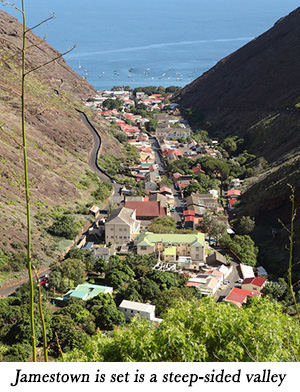 My head soon cleared and my next thought (right after "explain to me again why I didn't buy a full wetsuit for this trip?") was that fish were the reason for my lengthy journey to St. Helena, a British Overseas Territory in the South Atlantic, the most remote inhabited island on earth. Not specifically for the innumerable quarter-sized, view-blocking juvenile St. Helena butterflyfish, one of 28 endemic fish species of the island, but rather for the whale sharks promised by the tour operator's advertisement emailed to our local dive club. My fleeting disappointment never did reappear during our week of diving St. Helena (Hell-een'-ah), because fish were everywhere. The cold, however, occasionally got to me (one dive, 72ºF, 86 feet max for 58 minutes at Billy May's), fully testing my shorty, my Lavacore vest, and my resolve.
My head soon cleared and my next thought (right after "explain to me again why I didn't buy a full wetsuit for this trip?") was that fish were the reason for my lengthy journey to St. Helena, a British Overseas Territory in the South Atlantic, the most remote inhabited island on earth. Not specifically for the innumerable quarter-sized, view-blocking juvenile St. Helena butterflyfish, one of 28 endemic fish species of the island, but rather for the whale sharks promised by the tour operator's advertisement emailed to our local dive club. My fleeting disappointment never did reappear during our week of diving St. Helena (Hell-een'-ah), because fish were everywhere. The cold, however, occasionally got to me (one dive, 72ºF, 86 feet max for 58 minutes at Billy May's), fully testing my shorty, my Lavacore vest, and my resolve.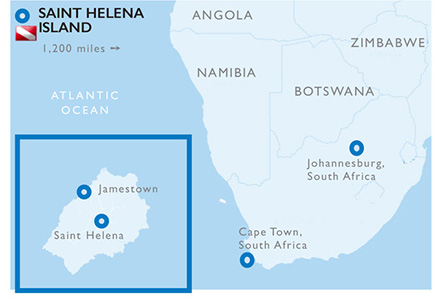 I had never seen 12-liter steel "stubbies" before and had to adjust BC straps set for aluminum 80s, retool valves from DIN to yoke, and perform calculus to equate lead into kg (the briefings were in meters and bar). Now I know how European divers feel in the Caribbean! They transported our gear down the pier to the RIB, loaded it with tanks, regulators, and BCs. Entering and exiting the RIB was sometimes a tricky affair due to wet pier surfaces, tides, and chop. Three knotted ropes hung from above for assistance, and one saved me the first time I boarded as the wet deck was surprisingly slippery, even in my sand sox. Going barefoot worked better.
I had never seen 12-liter steel "stubbies" before and had to adjust BC straps set for aluminum 80s, retool valves from DIN to yoke, and perform calculus to equate lead into kg (the briefings were in meters and bar). Now I know how European divers feel in the Caribbean! They transported our gear down the pier to the RIB, loaded it with tanks, regulators, and BCs. Entering and exiting the RIB was sometimes a tricky affair due to wet pier surfaces, tides, and chop. Three knotted ropes hung from above for assistance, and one saved me the first time I boarded as the wet deck was surprisingly slippery, even in my sand sox. Going barefoot worked better.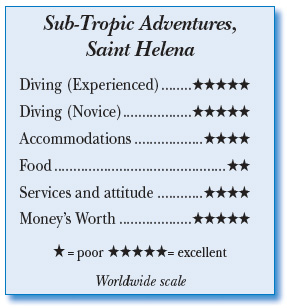 Although located at 16 degrees south latitude, about that of Fiji, St. Helena does not (really) have any corals, save for a few orange cup corals in some overhangs. The sea bottom is every geologic variety of weathered remnants of island volcanic activity, as St. Helena is resultant of two volcanoes last active 7 and 12 million years ago. Dive sites have huge pyroclastic boulders, while others have vast fields of tumbled stones. There are overhangs and swim-thrus, lava tubes, leaning slabs, and piled boulders. There are basaltic ledges, layered lava flows, fissured walls, layers of compressed volcanic ash, collapsed cliff faces, and every other manner of eroded volcanic formation. Vast areas are covered in a short, varied, and thick layer of life with which I was unfamiliar, but learned too soon that the 1.5-inch-long white feathery cute-looking things have a painful and itchy sting and leave marks visible after two weeks.
Although located at 16 degrees south latitude, about that of Fiji, St. Helena does not (really) have any corals, save for a few orange cup corals in some overhangs. The sea bottom is every geologic variety of weathered remnants of island volcanic activity, as St. Helena is resultant of two volcanoes last active 7 and 12 million years ago. Dive sites have huge pyroclastic boulders, while others have vast fields of tumbled stones. There are overhangs and swim-thrus, lava tubes, leaning slabs, and piled boulders. There are basaltic ledges, layered lava flows, fissured walls, layers of compressed volcanic ash, collapsed cliff faces, and every other manner of eroded volcanic formation. Vast areas are covered in a short, varied, and thick layer of life with which I was unfamiliar, but learned too soon that the 1.5-inch-long white feathery cute-looking things have a painful and itchy sting and leave marks visible after two weeks. 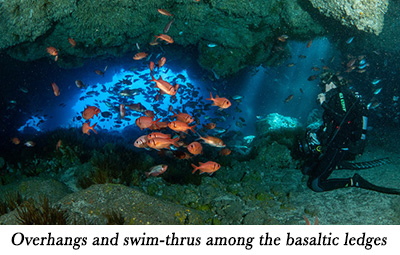 Several dives featured a fly-by from large Chilean devil rays (mobulas), a graceful sight as they appeared out of the ether; some moved in close and hung around. I was told that the week before, the devil rays were charging through clouds of the nickel-sized St. Helena butterflyfish, huge mouths agape. I spotted octopuses on almost every dive; with few nooks-and-crannies to hide in, they were easy to follow as they would jet a distance, then suck tight to a rock and change color and texture. It was a spectacle to watch and a challenge to video. My octopus-recording persistence was rewarded with a voluminous inking I caught on video.
Several dives featured a fly-by from large Chilean devil rays (mobulas), a graceful sight as they appeared out of the ether; some moved in close and hung around. I was told that the week before, the devil rays were charging through clouds of the nickel-sized St. Helena butterflyfish, huge mouths agape. I spotted octopuses on almost every dive; with few nooks-and-crannies to hide in, they were easy to follow as they would jet a distance, then suck tight to a rock and change color and texture. It was a spectacle to watch and a challenge to video. My octopus-recording persistence was rewarded with a voluminous inking I caught on video.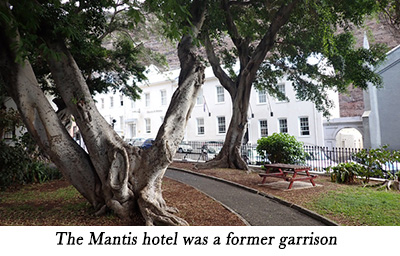 The Mantis has a bar with an abbreviated menu, and the hotel was the only fair restaurant option in town, but with fantastic service, which carried throughout the entire Mantis team during our stay. The chef was gracious enough to prepare a champagne dinner for our anniversary on his night off. Lunch was usually the only meal challenge due to time constraints and restaurant operating schedules. We were forced to consume bland offerings for several lunches that were at least inexpensive. It seemed that everything was fried. Fresh salads and vegetables were rare, as the resupply boat is on a three-week schedule. Every piece of fish I had was overcooked, even fresh tuna and wahoo. It was once necessary to use a knife on a piece of fresh-caught tuna. At Anne's Place, a "local" fish cake was made of dried salted cod served with mushy fries. When on a tight schedule to have lunch before returning for an afternoon whale shark snorkel, I was told "nothing" when I asked Anne what menu item would be quick. Rosie's was very good for our one meal but doesn't open until 3 p.m. and is above town, not in town. We went back for a Tanqueray and tonic while touring one afternoon to enjoy their panorama. They offer good burgers.
The Mantis has a bar with an abbreviated menu, and the hotel was the only fair restaurant option in town, but with fantastic service, which carried throughout the entire Mantis team during our stay. The chef was gracious enough to prepare a champagne dinner for our anniversary on his night off. Lunch was usually the only meal challenge due to time constraints and restaurant operating schedules. We were forced to consume bland offerings for several lunches that were at least inexpensive. It seemed that everything was fried. Fresh salads and vegetables were rare, as the resupply boat is on a three-week schedule. Every piece of fish I had was overcooked, even fresh tuna and wahoo. It was once necessary to use a knife on a piece of fresh-caught tuna. At Anne's Place, a "local" fish cake was made of dried salted cod served with mushy fries. When on a tight schedule to have lunch before returning for an afternoon whale shark snorkel, I was told "nothing" when I asked Anne what menu item would be quick. Rosie's was very good for our one meal but doesn't open until 3 p.m. and is above town, not in town. We went back for a Tanqueray and tonic while touring one afternoon to enjoy their panorama. They offer good burgers.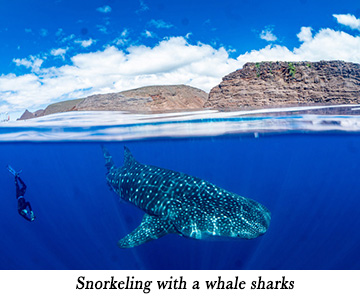 After 20 minutes, out of the abyss, an indigo apparition transformed into larger whale shark. As they circled us and each other, it was difficult for me to maintain the marine-park-mandated three-meter stand-off. Many times, I found myself directly in front of the behemoths, another marine park no-no. My frantic finning and their lethargic loll resulted in no bumping of me, but some close passes where I could look right into their tiny blank eyes. Soon, one chased the other off and then followed into the deep soon thereafter. Our second whale shark snorkel tour yielded a swim with three whale sharks, two of which were adolescent males. Much more jostling between the boys. When queried, the proprietor told me that he had once seen the dorsal fins of over forty individuals on one tour. Sub-Tropic Adventures also does an afternoon dolphin tour to visit a resident pod of 400 to 500 pantropical spotted dolphins. I think it rather amazing that a tour operator almost guarantees to deliver wild animal encounters to tourists daily, but such are the waters of St. Helena.
After 20 minutes, out of the abyss, an indigo apparition transformed into larger whale shark. As they circled us and each other, it was difficult for me to maintain the marine-park-mandated three-meter stand-off. Many times, I found myself directly in front of the behemoths, another marine park no-no. My frantic finning and their lethargic loll resulted in no bumping of me, but some close passes where I could look right into their tiny blank eyes. Soon, one chased the other off and then followed into the deep soon thereafter. Our second whale shark snorkel tour yielded a swim with three whale sharks, two of which were adolescent males. Much more jostling between the boys. When queried, the proprietor told me that he had once seen the dorsal fins of over forty individuals on one tour. Sub-Tropic Adventures also does an afternoon dolphin tour to visit a resident pod of 400 to 500 pantropical spotted dolphins. I think it rather amazing that a tour operator almost guarantees to deliver wild animal encounters to tourists daily, but such are the waters of St. Helena.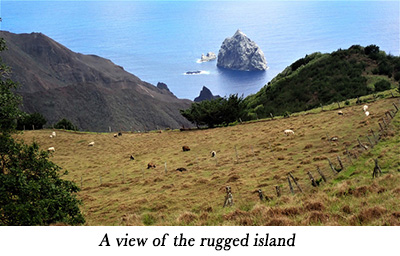 The island attained some notoriety and importance during the early 19th century as Napoleon Bonaparte's final exile. His residence at Longwood and his (now empty) lavish tomb at St. Paul's are popular tourist attractions, yet to visit it, you have to pass up morning dives, since it is open only between 11 a.m. and 1 p.m. hours some weekdays. The storage building for Napoleon's personal wine is alongside one of the main roads. St. Helena's history as an island prison continued with a Zulu chief exiled in the late 19th century, and for Anglo-Boer War POWs and the Sultan of Zanzibar held there during the early 20th century.
The island attained some notoriety and importance during the early 19th century as Napoleon Bonaparte's final exile. His residence at Longwood and his (now empty) lavish tomb at St. Paul's are popular tourist attractions, yet to visit it, you have to pass up morning dives, since it is open only between 11 a.m. and 1 p.m. hours some weekdays. The storage building for Napoleon's personal wine is alongside one of the main roads. St. Helena's history as an island prison continued with a Zulu chief exiled in the late 19th century, and for Anglo-Boer War POWs and the Sultan of Zanzibar held there during the early 20th century. 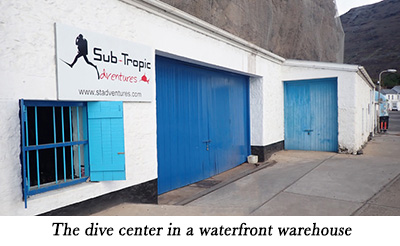 Our lone night dive was on the wreck of the SS Papanui, a triple expansion steam-engine-powered passenger/cargo vessel launched in 1898 for the New Zealand Shipping Company. Shortly after crossing the equator on her last voyage, a fire broke out in her coal bunkers. On September 11th, 1911, after burning for almost a week, the ship was run aground in James' Bay, in an attempt to save her. An earlier explosion and the subsequent raging fire doomed her, creating an interesting and easily-accessed snorkeling and night dive wreck site. The maximum depth was 40 feet, and we called it a night after 61 minutes. Several lobster species were represented, including the brightly colored red reef lobster, which looks like a red and orange crayfish only way cuter. Beyond the macro and night creature photo opportunities, was a beaten/salvaged wreck with part of the bottom strewn with champagne bottles. Some seemed intact, and the mythical occasionally found full bottle is the stuff of local lore. I didn't pick up a champagne bottle or an ancient-looking rum (?) bottle found on another dive site, near some cannons, as the local historical/maritime rules were unknown to me and better left untested. We also visited the Frontier wreck for 42 minutes at 88 feet max, a nice but largely nondescript steel shipwreck lying on its side and containing lots of fish and critters.
Our lone night dive was on the wreck of the SS Papanui, a triple expansion steam-engine-powered passenger/cargo vessel launched in 1898 for the New Zealand Shipping Company. Shortly after crossing the equator on her last voyage, a fire broke out in her coal bunkers. On September 11th, 1911, after burning for almost a week, the ship was run aground in James' Bay, in an attempt to save her. An earlier explosion and the subsequent raging fire doomed her, creating an interesting and easily-accessed snorkeling and night dive wreck site. The maximum depth was 40 feet, and we called it a night after 61 minutes. Several lobster species were represented, including the brightly colored red reef lobster, which looks like a red and orange crayfish only way cuter. Beyond the macro and night creature photo opportunities, was a beaten/salvaged wreck with part of the bottom strewn with champagne bottles. Some seemed intact, and the mythical occasionally found full bottle is the stuff of local lore. I didn't pick up a champagne bottle or an ancient-looking rum (?) bottle found on another dive site, near some cannons, as the local historical/maritime rules were unknown to me and better left untested. We also visited the Frontier wreck for 42 minutes at 88 feet max, a nice but largely nondescript steel shipwreck lying on its side and containing lots of fish and critters.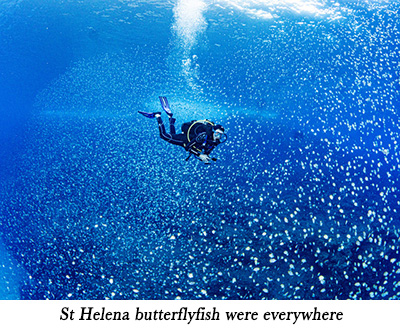 A week before I traveled, I learned of the government requirement that proof of medical-evacuation insurance must be produced at immigration. The tour operator recommended travel insurance, as standard, but never mentioned "required" to enter. (The government tourism website fails to note this important tidbit). I purchased a trip-specific travel plan with medical evacuation for our dive vacation from DAN for $493.
A week before I traveled, I learned of the government requirement that proof of medical-evacuation insurance must be produced at immigration. The tour operator recommended travel insurance, as standard, but never mentioned "required" to enter. (The government tourism website fails to note this important tidbit). I purchased a trip-specific travel plan with medical evacuation for our dive vacation from DAN for $493. Diver's Compass: We paid $1,517 each to get to Johannesburg, and $1,052 for the flight from JNB to HLE . . . It was $2,074 each for seven Mantis nights, seven breakfasts, four dinners, a full-day land tour, five days of two-tank dives plus two nights at the Safari Club in JoBurg, with two breakfasts and two dinners . . . Rental equipment was available, but most dive tourists brought their own gear. Mask, fins, and snorkels were available for whale shark snorkelers. Repair facilities were minimal, at best . . . The currency is the St, Helena pound, its value fixed to the British pound . . . My tour company, Indigo Safaris, run by Christopher Bartlett, is located in London.
Diver's Compass: We paid $1,517 each to get to Johannesburg, and $1,052 for the flight from JNB to HLE . . . It was $2,074 each for seven Mantis nights, seven breakfasts, four dinners, a full-day land tour, five days of two-tank dives plus two nights at the Safari Club in JoBurg, with two breakfasts and two dinners . . . Rental equipment was available, but most dive tourists brought their own gear. Mask, fins, and snorkels were available for whale shark snorkelers. Repair facilities were minimal, at best . . . The currency is the St, Helena pound, its value fixed to the British pound . . . My tour company, Indigo Safaris, run by Christopher Bartlett, is located in London. 